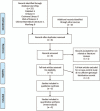Association study of single nucleotide polymorphism in tryptophan hydroxylase 1 gene with adolescent idiopathic scoliosis: A meta-analysis
- PMID: 33545939
- PMCID: PMC7837909
- DOI: 10.1097/MD.0000000000023733
Association study of single nucleotide polymorphism in tryptophan hydroxylase 1 gene with adolescent idiopathic scoliosis: A meta-analysis
Abstract
Background: Adolescent idiopathic scoliosis is a common spinal deformity among children and adolescents worldwide with its etiology uncertain. Over a decade, a single nucleotide polymorphism rs10488682 in tryptophan hydroxylase 1 (TPH1) gene has been investigated in several association studies. We perform this study to summarize the current evidence of TPH1 rs10488682 polymorphisms and adolescent idiopathic scoliosis (AIS).
Methods: Six databases were systematically searched: PubMed, Embase, Cochrane Library, Web of Science, Chinese Biomedical Literature, and Wanfang database. Eligible case-control studies related to TPH1 and AIS were selected. Reference lists of them were reviewed for more available studies. Two authors independently screened and evaluated the literature and extracted data. The odds ratios and 95% confidence intervals were derived in association tests. Subgroup analysis was conducted by ethnicity. Sensitivity analysis was performed to examine the stability of the overall results.
Results: A total of 1006 cases and 1557 controls in 3 independent studies were included for meta-analysis. Statistical significance was discovered in heterozygote model (AT vs AA: OR = 1.741, 95%Cl = 1.100-2.753, P = .018 < .05, I2 = 0%), recessive model (AA vs AT + TT: OR = 0.640, 95%Cl = 0.414-0.990, P = .045 < .05, I2 = 0%) and over-dominant model (AT vs AA + TT: OR = 1.366, 95%Cl = 1.115-1.673, P = .003 < .05, I2 = 84.7%) in overall populations. Similar associations were also found in the Caucasian population. No significant associations were found in other genotypic comparisons and allelic comparisons.
Conclusions: Statistically significant correlations were discovered between the TPH1 rs10488682 polymorphisms and AIS. Heterozygous AT genotype seems to be risky with an over-dominant effect. Ethnicity appears to modify the disease association.
Registration: Not applicable.
Copyright © 2021 the Author(s). Published by Wolters Kluwer Health, Inc.
Conflict of interest statement
The authors have no funding and conflicts of interest to disclose.
Figures





Similar articles
-
Association study of tryptophan hydroxylase 1 and arylalkylamine N-acetyltransferase polymorphisms with adolescent idiopathic scoliosis in Han Chinese.Spine (Phila Pa 1976). 2008 Sep 15;33(20):2199-203. doi: 10.1097/BRS.0b013e31817c03f9. Spine (Phila Pa 1976). 2008. PMID: 18794762
-
Lack of association between adolescent idiopathic scoliosis and previously reported single nucleotide polymorphisms in MATN1, MTNR1B, TPH1, and IGF1 in a Japanese population.J Orthop Res. 2011 Jul;29(7):1055-8. doi: 10.1002/jor.21347. Epub 2011 Feb 9. J Orthop Res. 2011. PMID: 21308753
-
Association between IGF1 gene single nucleotide polymorphism (rs5742612) and adolescent idiopathic scoliosis: a meta-analysis.Eur Spine J. 2017 Jun;26(6):1624-1630. doi: 10.1007/s00586-016-4742-7. Epub 2016 Aug 23. Eur Spine J. 2017. PMID: 27554350
-
The polymorphisms of melatonin receptor 1B gene (MTNR1B) (rs4753426 and rs10830963) and susceptibility to adolescent idiopathic scoliosis: a meta-analysis.J Orthop Sci. 2015 Jul;20(4):593-600. doi: 10.1007/s00776-015-0725-5. Epub 2015 Apr 22. J Orthop Sci. 2015. PMID: 25898821 Review.
-
Single nucleotide polymorphisms of estrogen receptors are risk factors for the progression of adolescent idiopathic scoliosis: a systematic review and meta-analyses.J Orthop Surg Res. 2024 Sep 28;19(1):605. doi: 10.1186/s13018-024-05102-2. J Orthop Surg Res. 2024. PMID: 39342385 Free PMC article.
Cited by
-
Dystrophinopathy in the paravertebral muscle of adolescent idiopathic scoliosis: a prospective case-control study in China.Asian Spine J. 2025 Feb;19(1):64-73. doi: 10.31616/asj.2024.0299. Epub 2025 Feb 4. Asian Spine J. 2025. PMID: 39905835 Free PMC article.
References
-
- Burshell AL, Nauman EA. Marcus R, Feldman D, Nelson DA, Rosen CJ. CHAPTER 45 – Adult scoliosis, degenerative disease, and BMD: a subsegmental analytic approach. Osteoporosis 3rd ed.San Diego: Academic Press; 2008. 1167–76.
-
- Cheng JC, Castelein RM, Chu WC, et al. Adolescent idiopathic scoliosis. Nat Rev Dis Primers 2015;1:15030. - PubMed
-
- Langensiepen S, Semler O, Sobottke R, et al. Measuring procedures to determine the Cobb angle in idiopathic scoliosis: a systematic review. Eur Spine J: official publication of the European Spine Society, the European Spinal Deformity Society, and the European Section of the Cervical Spine Research Society 2013;22:2360–71. - PMC - PubMed
-
- Miller NH. Cause and natural history of adolescent idiopathic scoliosis. Orthop Clin North Am 1999;30:343–52. vii. - PubMed
Publication types
MeSH terms
Substances
LinkOut - more resources
Full Text Sources
Other Literature Sources
Medical

